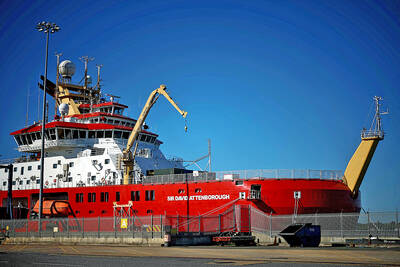After two hours of scouring the beaches of Pongara National Park in the dark night, Joan Ikoun-Ngossa and his patrol finally find a leatherback turtle.
It has just laid its eggs and is struggling awkwardly back to the sea.
For its young, however, there is just a one in 1,000 chance of making it to adulthood, thanks to a deadly combination of humans, natural predators, pollution and sometimes sheer bad luck.
With the help of a light — colored red, so as not to dazzle or upset the turtle — Ikoun-Ngossa of Aventures Sans Frontieres (ASF — Adventures Without Borders) climbs onto the animal to take measurements.
It comes in at 1.6m long and 1.11m wide.
The leatherback is the world’s largest species of turtle — they can live for up to 80 years and reach 2.4m in length. However, it is critically endangered.
After measuring the turtle, Ikoun-Ngossa attaches a ring on its back leg to track its progress after it leaves the Gabonese coast.
Clumsy and awkward on land, the turtle disappears in a few strokes once it reaches the water, leaving behind great crawl marks in the sand like the tire tracks of a four-wheel-drive.
During the two-month egg-laying season, beginning in October, the turtles scramble onto the beach at night, dig a hole, lay their eggs inside and cover them with sand before departing again.
The whole process takes a little less than two hours.
The females lay between 50 and 120 eggs, and one in three is a “dud,” with no embryo inside, says Ikoun-Ngossa, a former boatman who now works to protect his country’s wildlife.
“The dud eggs are part of the nest. They contribute to regulate the airflow and temperature, and no doubt nature probably intended them as a kind of decoy for predators,” he says.
There is no shortage of predators: monitor lizards, crabs and birds, which are all part of the natural order, but also humans, who sometimes find and eat the eggs, and dogs that dig them up.
“Of a thousand eggs laid, we estimate that only one will survive to become an adult turtle,” said Angela Formia of the Wildlife Conservation Society.
Ikoun-Ngossa stays on the Pongara beaches from October to April to try to improve the eggs’ chances of survival.
“If the turtle lays below the waterline, the eggs have no chance so we take those ones and put them in a special enclosure” further up the beach, he said.
This “maternity ward” is currently host to more than 300 eggs.
After two or three months, the eggs hatch and the baby turtles, just a few centimeters long, crawl toward the sea, where many are eaten by birds, sharks and other predators.
“Currently there are around 40,000 females which come to Gabon, and this is the largest leatherback turtle population in the world,” Formia said.
Females lay their eggs every two or three years, Ikoun-Ngossa explains, and study of the tracking devices has shown one turtle can lay up to three batches of eggs in ten days before swimming off again.
Knowledge of the turtles’ lives outside these laying periods is limited.
“The data shows they move to the cold waters in the middle of the Atlantic and to the south,” Formia said. “A number have been recorded off the coast of Brazil and Argentina.”
Leatherback turtles play a big role in traditional Gabonese stories. Legend has it they overcame leopards, snakes and crocodiles through their cunning.
Today, many observers believe the leatherback turtle is facing extinction unless more is done to safeguard their welfare.
They say the biggest threat to their survival comes not from predators but from man-made pollution, in particular plastic bags which turtles mistake for jellyfish — their main diet.

STEPPING UP: Diminished US polar science presence mean opportunities for the UK and other countries, although China or Russia might also fill that gap, a researcher said The UK’s flagship polar research vessel is to head to Antarctica next week to help advance dozens of climate change-linked science projects, as Western nations spearhead studies there while the US withdraws. The RRS Sir David Attenborough, a state-of-the-art ship named after the renowned British naturalist, would aid research on everything from “hunting underwater tsunamis” to tracking glacier melt and whale populations. Operated by the British Antarctic Survey (BAS), the country’s polar research institute, the 15,000-tonne icebreaker — boasting a helipad, and various laboratories and gadgetry — is pivotal to the UK’s efforts to assess climate change’s impact there. “The saying goes

Police in China detained dozens of pastors of one of its largest underground churches over the weekend, a church spokesperson and relatives said, in the biggest crackdown on Christians since 2018. The detentions, which come amid renewed China-US tensions after Beijing dramatically expanded rare earth export controls last week, drew condemnation from US Secretary of State Marco Rubio, who on Sunday called for the immediate release of the pastors. Pastor Jin Mingri (金明日), founder of Zion Church, an unofficial “house church” not sanctioned by the Chinese government, was detained at his home in the southern city of Beihai on Friday evening, said

TICKING CLOCK: A path to a budget agreement was still possible, the president’s office said, as a debate on reversing an increase of the pension age carries on French President Emmanuel Macron yesterday was racing to find a new prime minister within a two-day deadline after the resignation of outgoing French Prime Minister Sebastien Lecornu tipped the country deeper into political crisis. The presidency late on Wednesday said that Macron would name a new prime minister within 48 hours, indicating that the appointment would come by this evening at the latest. Lecornu told French television in an interview that he expected a new prime minister to be named — rather than early legislative elections or Macron’s resignation — to resolve the crisis. The developments were the latest twists in three tumultuous

FIRST STAGE: Hamas has agreed to release 48 Israeli hostages in exchange for 250 ‘national security prisoners’ as well as 1,700 Gazans, but has resisted calls to disarm Israel plans to destroy what remains of Hamas’ network of tunnels under Gaza, working with US approval after its hostages are freed, it said yesterday. Israeli Minister of Defense Israel Katz said that the operation would be conducted under an “international mechanism” led by the US. “Israel’s great challenge after the hostage release phase will be the destruction of all Hamas terrorist tunnels in Gaza,” Katz said. “I have ordered the army to prepare to carry out this mission,” he added. Hamas operates a network of tunnels under Gaza, allowing its fighters to operate out of sight of Israeli reconnaissance. Some have passed under